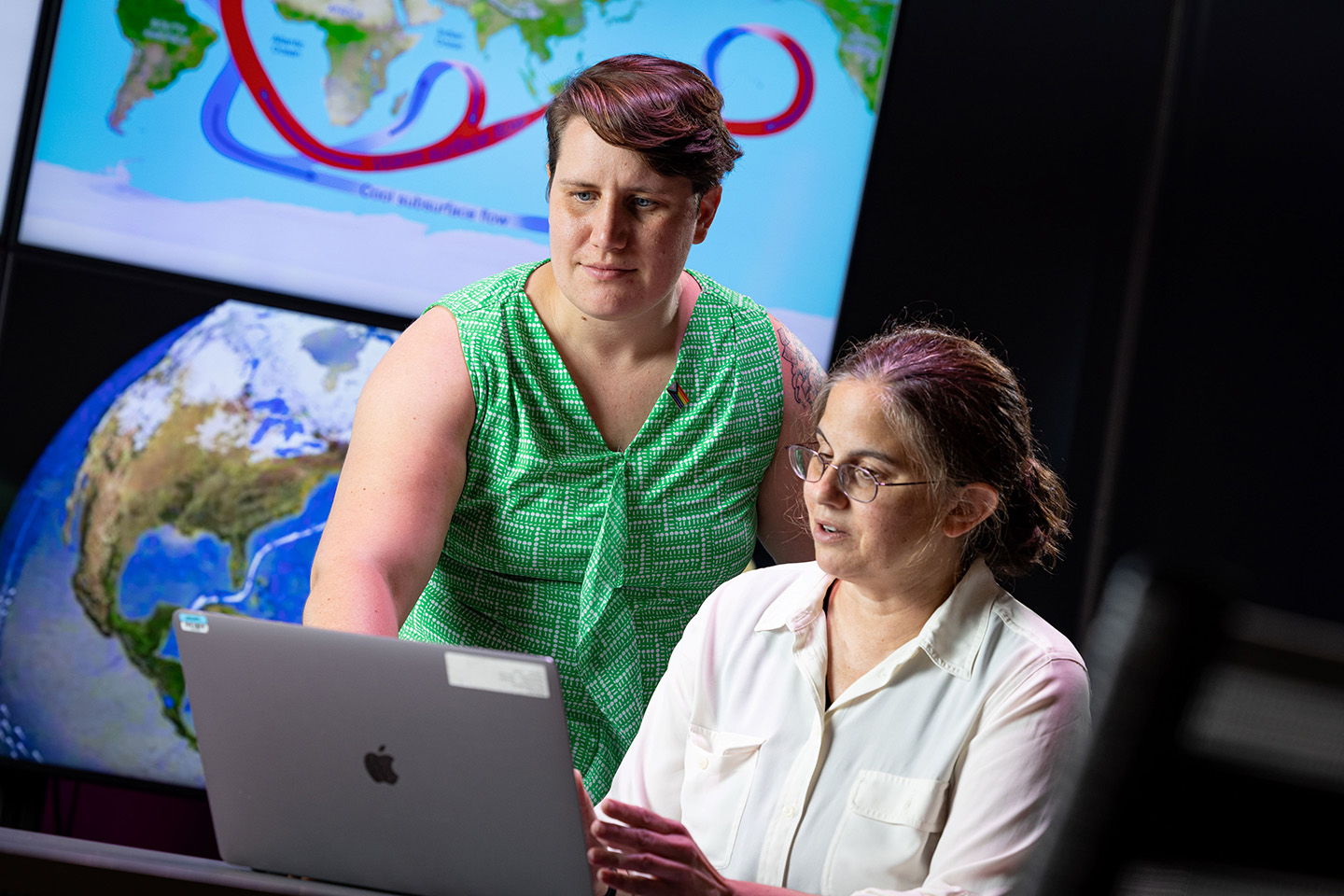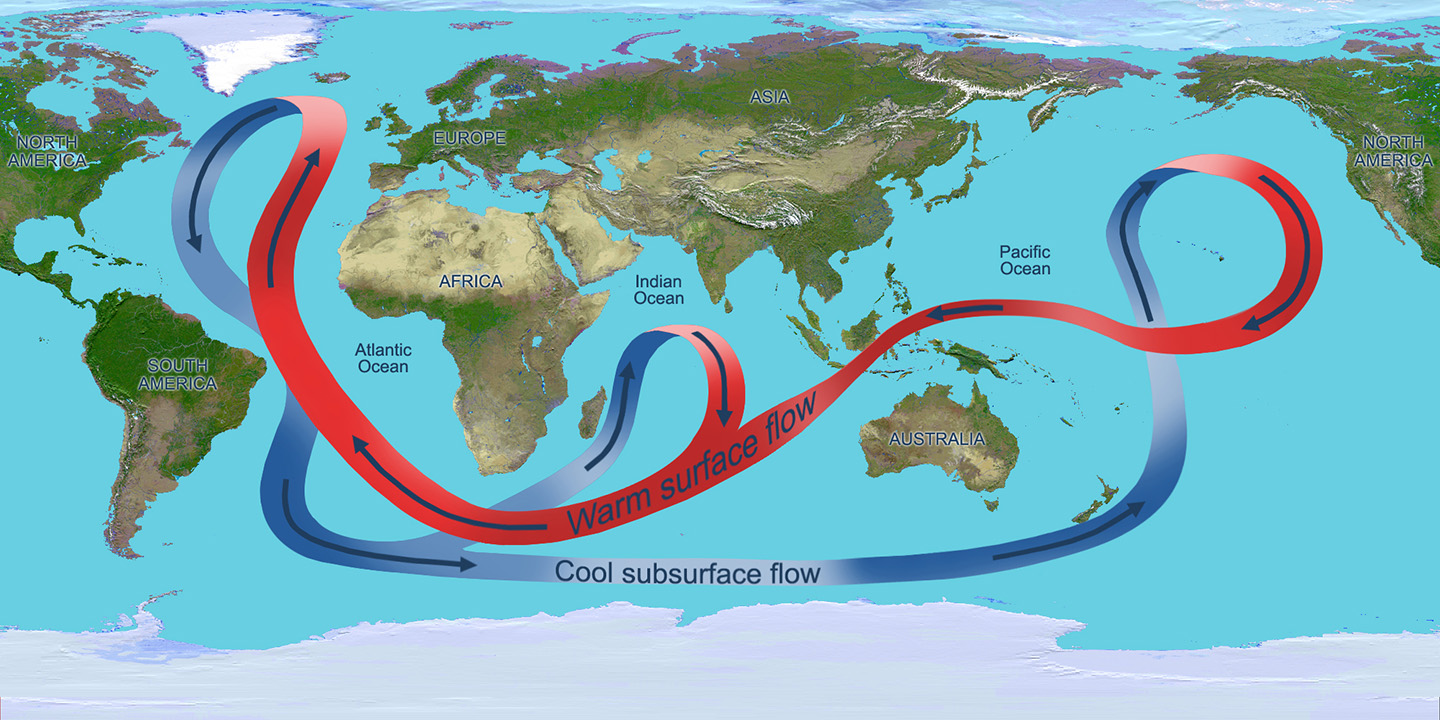Widespread, Rapid and Intensifying
Widespread, rapid and intensifying — these are the terms the Intergovernmental Panel on Climate Change uses in its Sixth Assessment Report to describe climate change. In the report, the panel concluded that more than a dozen natural systems — from ice sheets to the Amazon rainforest — are at risk of tipping.
Sleeman’s team is taking on one of those systems as a use case: the Atlantic Meridional Overturning Circulation (AMOC), a large-scale system of ocean currents that circulates warm, salty water from the South Atlantic and tropics via the Gulf Stream to the colder North Atlantic. There, warm salty waters cool, release heat, and eventually sink to the deep ocean and move south.
“It’s often referred to as the ‘global conveyor belt’ and is an important climate system, as it is central to how heat and freshwater are transported,” Sleeman said. “Some of the more modern climate models that offer ultra-high resolution of the oceans have predicted a slowing of the AMOC, or even a full collapse of the system. And there’s been some speculation that a full collapse of the AMOC could have long-term negative effects on food security, sea levels, delicate ecosystems and the Arctic.”
Some researchers are also concerned that a collapse of the AMOC could trigger other climate tipping points, causing a cascading effect.
To build a tool that could predict conditions that may lead to a collapse of the AMOC, the team leveraged deep learning methods and neuro-symbolic representations. They also drew upon surrogate ocean models developed by JHU’s Anand Gnanadesikan, the co-principal investigator on PACMANS.
Gnanadesikan is a renowned oceanographer who more than 20 years ago developed a model that showed how seemingly subtle changes in the oceans could produce significant results around the world, providing scientists a better understanding of the greenhouse effect and global warming on these systems.
“We created a simulated AI environment using adversarial-based deep learning networks,” Sleeman explained. “One is perturbing and generating tipping points, and the other is learning to recognize a tipping point and how to modify conditions to move away from a tipping point.”
To prove the fidelity of the resulting models, the researchers attempted to recreate experiments Gnanadesikan conducted in 2018 that showed that global climate models used to predict future climate changes might significantly overestimate the stability of the Atlantic meridional overturning circulation under anthropogenic global warming.
“We have been able to show that the AI methodology is able to learn to recreate the same experiments that Dr. Gnanadesikan described [using the same parameters],” Sleeman said. “The AI methodology was able to learn the boundaries of the area [in state space] where the tipping points are likely to occur, and this was consistent with the model configurations (parameters and initial conditions) that, with great uncertainty, are harder to classify AMOC as collapsed or not.”
The team also wanted to develop a new language that will enable translation between “what if” questions and the simulated AI environment. This approach pushes climate modeling into the third wave of AI by extending “explainability,“ Sleeman said.
“In the scientific domain, machine learning and, in particular, deep learning are seen as black boxes in terms of how they form their conclusions or predictions,” she said. “This is unacceptable in the scientific community because researchers prefer methods that produce results that are provable. So, the explainability component is key in allowing the scientist to understand how the AI methods reach their conclusions.”
Sleeman and Gnanadesikan presented preliminary findings from the team at the Association for the Advancement of Artificial Intelligence (AAAI) 2022 Fall Symposium Series, and at the American Geophysical Union’s Fall 2022 Meeting. They also presented the work at the 103rd American Meteorological Society Annual Meeting last month. In addition, the Laboratory is hosting a AAAI Spring 2023 Symposium, which will highlight this work, along with other AI-based approaches for climate tipping point discovery.
“There are climate impact researchers who have been working in this space for decades, technologists at new climate start-ups endeavoring to change the world, and emerging climate strategists and leads across our sponsor community,” said Marisa Hughes, the assistant program manager in APL’s Biological and Chemical Sciences program, who helps manage the Laboratory’s climate change efforts. “APL has expertise that can be utilized in this arena, but we know we can’t do it in a vacuum. Our collaboration with Dr. Gnanadesikan and his team is critical to this effort.”
Learn more about APL’s work on related climate challenges at the APL Climate Security page.

